Trump 2.0: What mean?
My key takeaways
No doubt you have been falling under an avalanche of commentary on the recent U.S. elections. Nonetheless, as much for my own thinking and maybe useful for others, I gather my takeaways here.
Americans’ choice
You can’t trust polls! At least not on Donald Trump. The polls predicted a nail-bitingly close election. Instead Trump got an outright majority of the popular vote (50.5% as of writing, to Kamala Harris’ 47.9%) and a solid majority of the Electoral College. Scott Greer was one of the minority of commentators who foresaw a strong Trump victory on the basis that polls had also underestimated the vote for him in 2016 and 2020.
Americans had a real choice in terms of both personality and policies: America’s two-party system is often criticized for failing to provide a genuine choice to voters. This year, whatever one thinks of the two options, voters had a real choice (besides their innumerable choices in congressional elections, state elections, and ballot initiatives in different states).
Trump focused on a few memorable major issues: tariffs to protect American workers, “mass deportations” and border enforcement, deregulation, and domestic fossil fuel production (“drill, baby, drill”).
Harris ran as a conventional Democrat and largely failed to distinguish herself form the incumbent Joe Biden (indeed, the current Administration bills itself as the “Biden-Harris Administration” and it seems Harris has played a significant role in the executive, perhaps especially with Biden’s cognitive decline). A vote for her would have meant more predictability at home and abroad.
The candidates also had clear differences on Diversity, Equity, and Inclusion (DEI); Critical Race Theory (CRT); trans, and other issues.
Americans also had a significant choice in terms who would appoint Supreme Court justices over the next for years, with huge legal and policy ramifications, a we saw on abortion and regulatory issues.
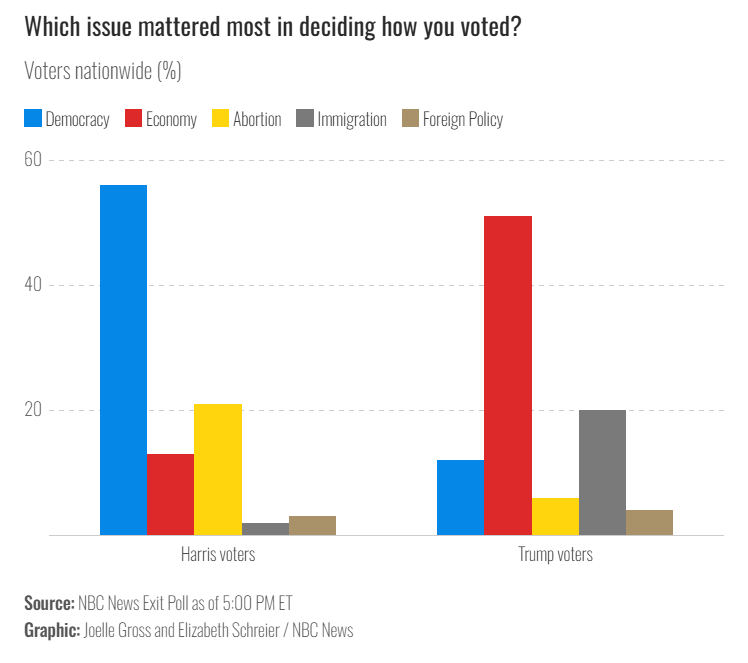
Why did a majority of Americans vote for Trump? Here are some of the potential motivators:
The economy, cost of living, and inflation. This is what Trump voters mention the most. This is despite the fact inflation is down from a pandemic-era peak of 9.1% to 2.4%, unemployment is at 4.1%, and the U.S. economy grew 2.5% in 2023. While overall inflation has been greater than wage growth during Biden’s term, wages have been slightly outgrowing inflation since June 2023. These are figures many other developed economies can only envy.
Besides a rejection of Bidenomics, many voters may be making a rational economic calculation that they would be better off under Trumpenomics’s formula of industrial protectionism, cheap fossil energy, deregulation, and tax cuts.
Massive illegal immigration. The Biden Administration saw a huge spike in illegal immigration with an estimated over 10 million illegal entries since October 2020. That’s an astonishing over 2.5 million people entering the U.S. illegally every year. A lot of voters do not like this and may blame illegal immigrants for contributing to problems of drugs, crime, pressure on social services and housing, downward pressure on wages, etc.
Opposing the uniparty. Many Americans resent and/or fear the power of collusion between progressives in Big Tech, the media, the Democratic Party, and elements of the “Deep State.” Social media and mainstream media’s suppression of compromising information on Hunter Biden’s laptop during the 2020, encouraged by former intelligence officials who baselessly claimed the scoop “has all the classic earmarks of a Russian information operation.” Elon Musk has voiced fears, share by many, that Democrats are encouraging immigration and naturalization to form reliably left-wing voting blocs to turn the reduce the U.S. to California-style permanent Democratic rule.
“Anti-woke” revolt: Opposition to DEI as discriminatory and unmeritocratic, to woke censorship (“deplatforming,” “canceling”), to CRT as anti-white and anti-American (see the considerable growing popularity of Chris Rufo), opposition to defunding the police, and to trans excesses (e.g., male-to-female trans in women’s sports or depriving parents of custody of their children should they resist their gender transition).
More prosaically, the Trump win may have simply been part of an anti-incumbent wave, especially if people were fatigued or skeptical of current governments following the various unprecedented, onerous, and costly COVID-19 measures.
I suspect there’s also something more intangible, reflected in the male shift of the vote: on a simple tribal and gut level, many like the idea of the big man standing up for them against out-groups (illegal immigrants, Chinese workers, corporations…). This may resonate more emotionally for many people than their objective economic circumstances or “receiving a handout” from a Democratic government.
Harris did not provide sufficiently compelling reasons to vote for her. No doubt the massive opposition of many young Americans (often raised to value anti-racist and anti-colonial narratives) to Israel’s conduct of the Gaza War, which the Biden-Harris Administration has effectively supported, has demoralized many on the left this campaign season.
What has MAGA become?
In MAGA, Americans have clearly made a choice in favor populist civic nationalism. This entails a more forthright defense of American citizens’ interests, regardless of ethnic background, notably in the form of immigration enforcement and tariffs. Arguably the intellectual figure who most prefigured this movement is Steve Sailer who has long advocated for “citizenism” which “affirms that true patriots and idealists are willing to make sacrifices for the overall good of their fellow American citizens rather than for the advantage of either six billion foreigners or of the special interests within our own country.”
MAGA is now a confirmed multiracial movement leading the racial depolarization of American politics: around 45% of Hispanics voted for Trump—a 13 point increase from 2020!—including a majority of Hispanic men. 38% of Asians also voted for Trump. This is hugely significant as Hispanics and Asians are the fast-growing ethnic demographics in America. The level of Hispanic support for Trump is unheard of for Republican presidential candidates: in the past Republicans struggled to even get 30% support. There is a huge gap between cultural elites’ constant denunciation of Trump as racist and Nazi-like, and his growing cross-racial appeal.
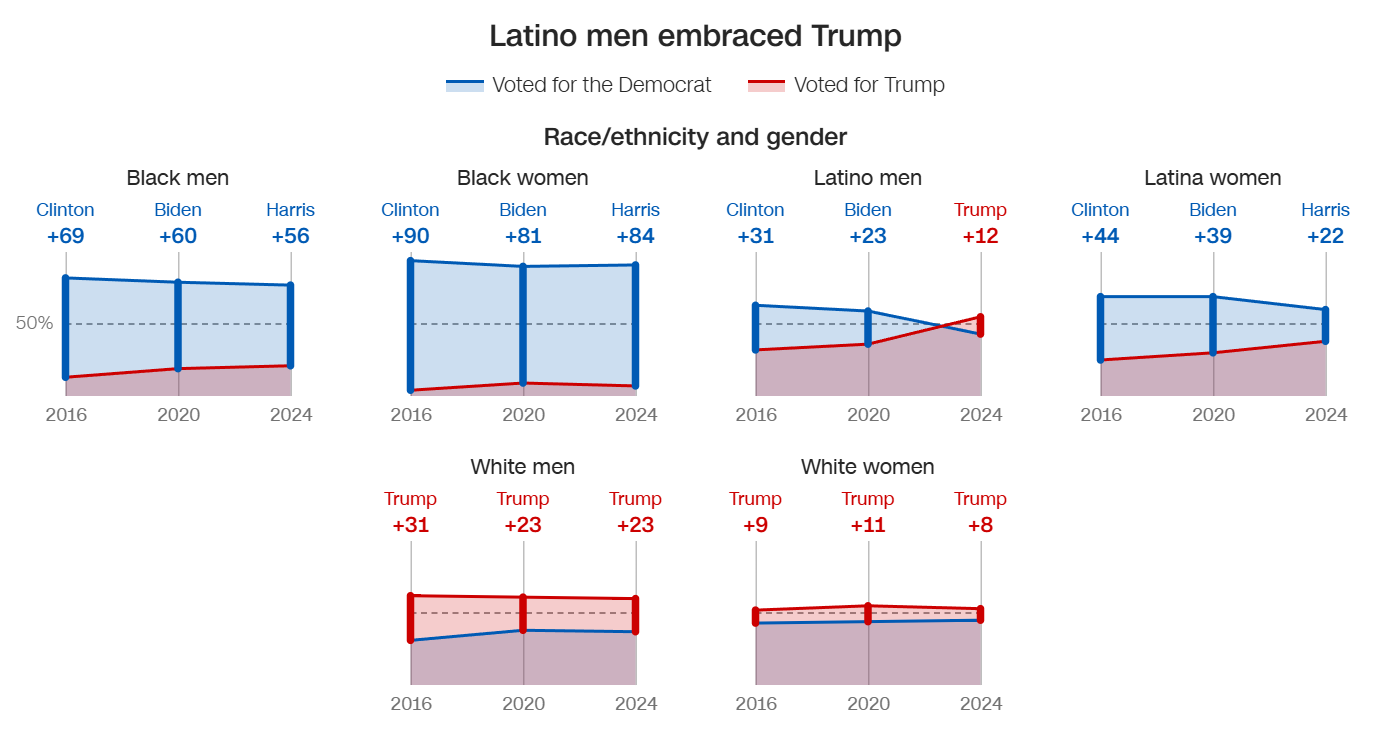
Trump did not do particularly well among African-Americans. On the other hand, Harris failed to mobilize the black vote and in particular the black male vote (despite much hectoring by Barack Obama and others during the final weeks).
MAGA is now a confirmed working class movement. While college-educated men voted about the same for Harris and Trump, Trump beat Harris by 24 points among non-college-educated men. Harris and the Democrats raised significantly more campaign funds of $2.3 billion, compared Trump and the Republicans’ $1.8 billion. In just about every swing state, Trump dominated rural areas while Harris led in major cities. Back in 2020, Trump-voting counties produced only 30% of U.S. GDP and Biden-voting counties 70%, an astonishing gap.
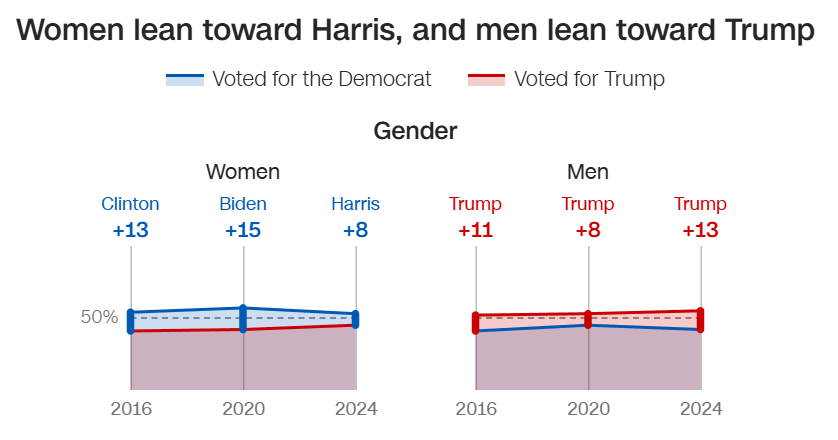
American politics remains deeply sexually polarized. Harris won among women of color and unmarried women. Part of Democrats’ appeal to women is due to the conservative Supreme Court’s 2022 Dobbs decision allowing states to regulate or ban abortion. (Significantly, in Trump-supporting Florida a majority of voters backed a ballot initiative defending abortion; so voters may be able to separate federal and states issues.) It seems to me this sexual polarization will be around for a long time to come and goes far beyond abortion, reflecting profound average differences in what emotionally resonates with men and women.
Trump won based on a new Republican coalition:
Religious conservatives, who have been happy with Trump’s Supreme Court picks but alarmed at his comments in favor of abortion in his home state of Florida, against a national abortion ban, and in favor of insurance covering IVF.
Economic conservatives, while happy with Trump’s deregulation promises and previous tax cuts, are alarmed by what they consider to be demagogic and distortive economic promises (Trump floated during the campaign ideas of cutting taxes for tips, Social Security, overtime, police, firefighters, veterans…) and upcoming massive budget deficits.
Israel supporters, who are generally very happy with Trump.
National populists, the critical new addition, who oppose illegal immigration and favor protectionist tariffs. This component appears to have been crucial for Trump’s unlocking of both white and Hispanic working class support for the GOP. National populists tend to also be vaguely socially conservative or at least allergic to wokism. Trump’s choice of J. D. Vance as his vice president is should make national populism part of the GOP’s DNA for the years to come.
The Tech Right as embodied by entrepreneurs like Elon Musk, Peter Thiel, and Marc Andreesen support innovation and deregulation, while opposing political correctness.
It remains to be seen whether the GOP can keep each component of this coalition sufficiently happy to stick together and how it will triangulate between them going forward.
What does a Trump 2.0 presidency mean going forward?
Checks and balances are still in place: Trump did significant damage to the American democratic process by refusing to concede his defeat in the 2020 elections. Trump’s ability to become a “dictator,” as feared by many, is highly constrained by the U.S. political system. Republicans will at best have slim majorities in the Senate and the House of Representatives. While the Supreme Court now has a conservative majority, the justices are not beholden to Trump’s personal interests but are following their consciences according to well-established judicial schools of thought. Democrats who are delegitimizing the Supreme Court as “MAGA court” are in my view acting irresponsibly.
Domestically, I predict Trump will achieve a great deal on tariffs, illegal immigration, deregulation, and energy. This can be achieved with a mixture of executive, regulatory, and legislative action. Some of these domestic actions will have international impact, e.g. undermining international climate talks.
On specifically legislative work, it is unclear what and how much the Republican-majority Congress will be able to achieve. U.S. presidents expend their “legislative capital” quickly and are often a mere two years away from losing congressional support in mid-term elections, thus becoming lame ducks. For example, even Ronald Reagan, the most celebrated conservative president of recent memory, largely governed from the center when it came to legislation. The “Reagan Revolution’s” legislative achievements were arguably modest outside the area of tax cuts—Reagan’s cuts, among other things, reduced the highest personal income tax from 70% to 28%—with the welfare state acquis (Social Security, Medicare, Medicaid) being largely left in place.
Internationally is where Trump is least predictable. Firstly because his ideas are least articulated in that area. Secondly because it is still uncertain whether the U.S. foreign policy establishment and national security state (“the Blob”) will go along with his agenda or largely sabotage it as during his first term. (For a taster of the chaos and sabotage within the first Trump White House, see this interview with his former national security adviser H. R. McMaster.) I would guess Trump will firmly support Israel, try to find a negotiated settlement in Ukraine, and in some sense seek to limit U.S. international engagement in general. But these are only guesses. In many areas foreign policy under Trump is unlikely to differ significantly from more traditional presidents.
With the Republican Party now firmly behind him, Trump will be stronger in the face of federal bureaucracies and perhaps face less infighting. However, much of the instability of the first Trump term was due to his fly-by-the-seat-of-his-pants management style. As Trump explained in the first two pages of The Art of the Deal back in 1987: “I play it very loose. I don’t carry a briefcase. I try not to schedule too many meetings. I leave my door open. You can’t be imaginative or entrepreneurial if you’ve got too much structure. I prefer to come to work each day and just see what develops.”
Assessments of how Trump 2.0 will do vary wildly.
Popular thought-provocateur Richard Hanania argued in favor of voting for the GOP in spite of being the party of stupid and uneducated people on economic grounds: economic freedom in the form of tax cuts, deregulation, and cracking down on unions in his view is the critical factor for America’s long-term dynamism. In this reading, the GOP as the party of big business will pass a pro-growth agenda while throwing populist fig-leaves to secure support from low-information voters with short attention spans, while the Democrats remain more beholden to deeply entrenched bureaucratic interests.
Repentent Russian ex-nationalist Anatoly Karlin predicts Trump will create a “kakistocracy” (rule by the worst people) marked by systemic cronyism, nepotism, and corruption, on the Putinist model. Trump in his view will wreck the institutional foundations of American prosperity, such as by attacking the rule of law (Trump’s “legal nihilism”) and undermining of the independence of the Federal Reserve.
Structural factors going forward

A “minority-majority” America is baked in the cake. This is independent of the success or lack thereof of Trump’s “mass deportations,” reduction of illegal immigration, and weakening of birthright citizenship. Trump in any event does not oppose significant and continuous legal immigration. Already in 2019, whites made up less than half of children under 15. Whites make up just 52% of young adults aged 18-24. The United States has previously been forecast to become minority white by the 2040s.
As whites decline, whether the GOP can continue to winning elections will depend on consolidating and furthering appeal among minorities, notably Hispanics and Asians, and perhaps to expanding support among black men.
Wokism is here to stay. There are innumerable examples of conservative movements winning elections and being quite powerless to stop broad societal change towards more liberalism. You might govern thanks to support by established people, families, and older people, but the new generations of young people will go there own way. Many people in media and academia will remain “woke.” Many “woke” youth will have growing influence as they rise up in society in the years to come. Trumpism may slow wokism’s progress by attacking CRT, defunding politicized academia and schools, or by getting promises of more balanced coverage from media owners (the Washington Post’s under Jeff Bezos and Los Angeles Times’ decisions to not back either candidate were very significant in this respect), but wokism is very unlikely to go away.
Wokism is bad for the Left’s governing prospects. Greta Thunberg recently wrote on Instagram: “[N]o matter if Trump or Harris wins, the USA—a country built on stolen land and genocide on indigenous people will still be an imperialist, hyper-capitalist world power that will ultimately continue to lead the world further into a racist, unequal world with an increasingly escalating climate- and environmental emergency.” This kind of extreme selective anti-national moralism, which is characteristic of wokism, makes it harder for the Left to simultaneously unify its coalition and appeal to mainline voters. (Incidentally, Thunberg’s native Sweden was originally settled by Western Hunter Gatherers before the land was violently conquered and I presume “stolen” by the Proto-Germanic branch of the Indo-Europeans. Humans have been around long enough that it’s hard to find any inhabited scrap of land which wasn’t “stolen” from somebody else.)
The mainstream / “legacy” media’s influence is at an unprecedentedly low ebb. A majority of Americans voted for Trump despite his being rejected by the overwhelming majority of the media, often in the strongest terms. The GOP in particular seems “emancipated” from the media and largely impervious to media criticism and ostracism, a first.
Conversely, the influence of social and alternative media like podcasts is stronger than ever.
Relatedly, no doubt also due to demographic trends, political correctness is weaker than ever in the American Right and among many voters. Just browse X and see the kinds of risqué memes out there.
The decline of PC and the rise of alt-media is in my view both good in bad. On the one hand, PC has tended to shut down truthful claims that are perceived to be offensive or harmful to designated victim groups.
On the other hand, while free of the mainstream media’s particular biases, many new alt-media may have their own worse biases, be more journalistically incompetent, or be outright epistemically bankrupt. Looking at the top podcast rankings, Tucker Carlson, the #2 podcast in the USA, has claimed nuclear weapons were invented by “demons,” while Candace Owens at #11 believes “Frankists masquerading as Jews” launched the French and Bolshevik Revolutions.
Like it or not, America is still growing in size and power. Unlike Europe, Russia, and Japan, the United States’ share of global GDP has been largely stable for decades at around one quarter. The U.S. population has grown by over 50 million over the past 25 years and will continue to grow, albeit at a slower pace, due to relatively higher fertility and immigration. The U.S., sometimes rivaled by China, dominates in fields critical to the future like tech, AI, biotech, and space. To put things frankly: people may often not like America, but America will remain profoundly relevant. Other developed nations need to ask themselves why they find themselves dwindling away in global significance and how to reverse this.
Speaking at a European summit, French President Emmanuel Macron said: “I think our role here, within the European Union, is not to comment on Donald Trump’s election, whether this is good or bad. … He has been elected by the American people and will defend Americans’ interests. … The question is: Are we ready to defend Europeans’ interests?”
In her gracious concession speech, Vice President Harris said: “In our nation, we owe loyalty not to a president or a party, but to the Constitution of the United States, and loyalty to our conscience, and to our God. … while I concede this election, I do not concede the fight that fueled this campaign—the fight: the fight for freedom, for opportunity, for fairness, and the dignity of all people.”


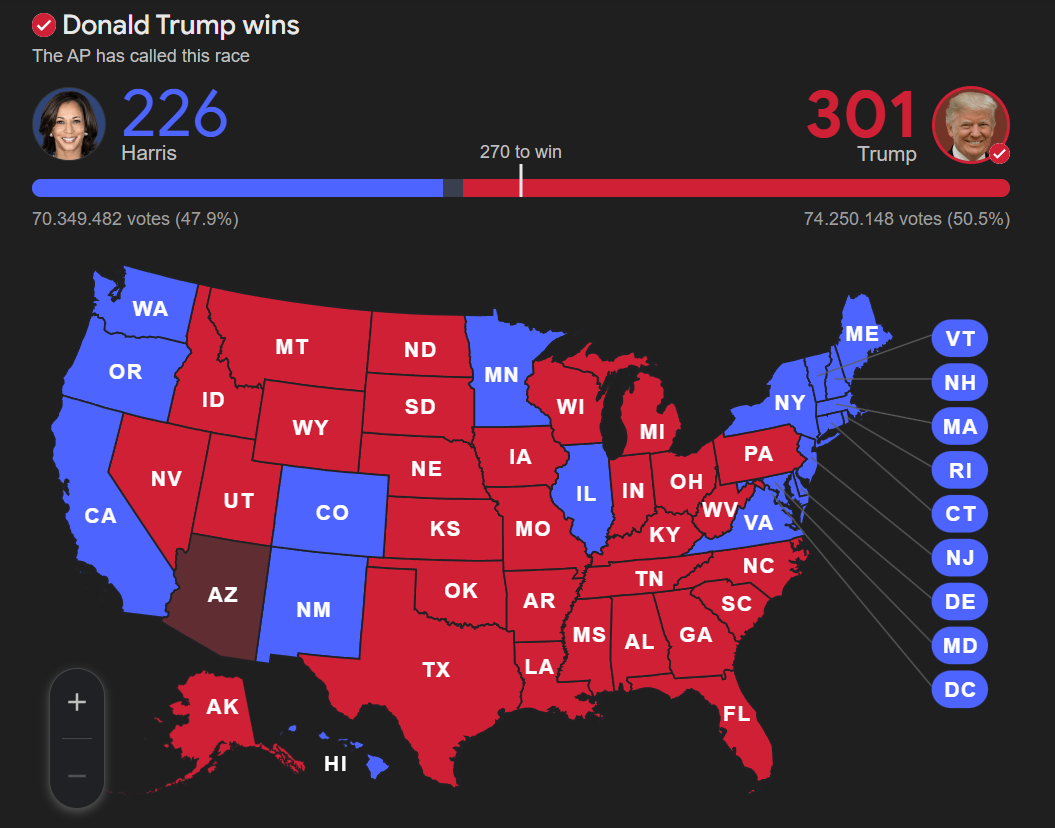
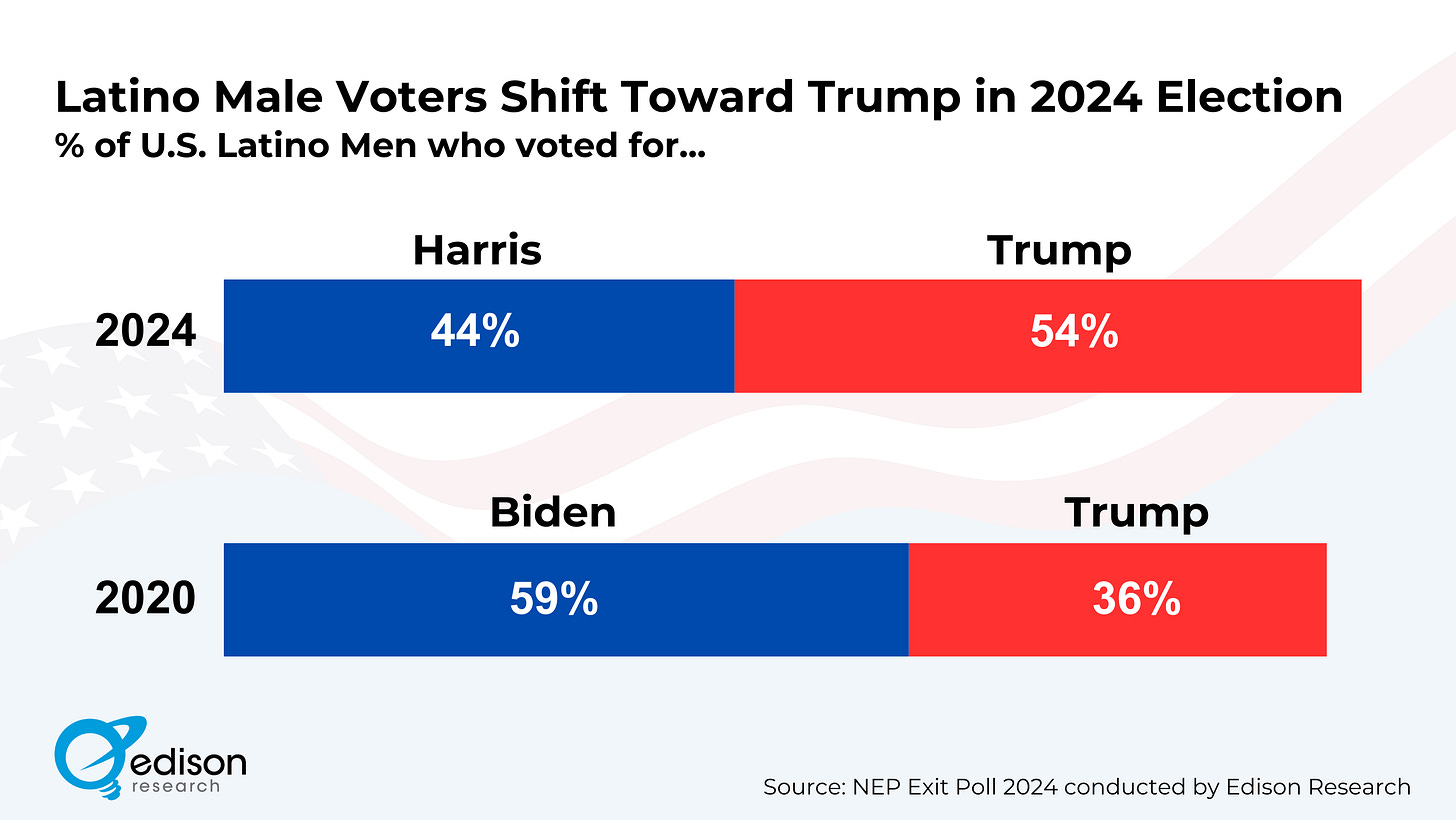
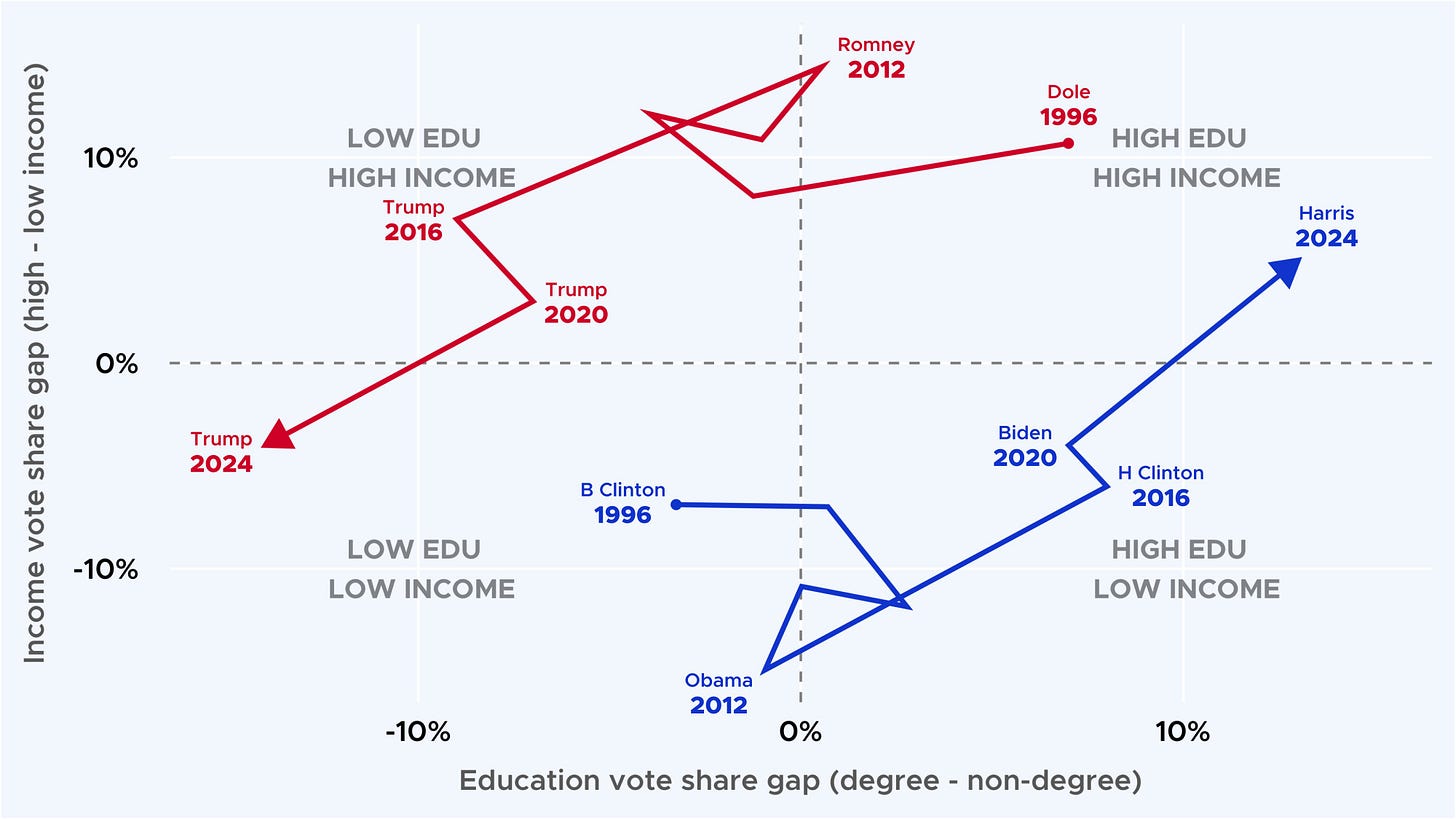

Regarding pollsters, there is one exception: São Paulo-based AtlasIntel, which correctly predicted that Trump would win all swing states as well as the popular vote. (AtlasIntel was also the most accurate pollster in 2020). However, even AtlasIntel underestimated Trump's margin of victory in all swing states except Michigan, by a margin of 0.2-1.1%. In contrast, the predictions for Harris' results were extremely accurate (within 0.0-0.3%).
https://atlasintel.org/poll/usa-national-2024-11-04
https://atlasintel.org/poll/usa-key-states-2024-11-04
Maxim Lott posted the adjusted poll data here, from September 2nd. I asked him to post the updated results given election results.
https://www.maximumtruth.org/p/can-polling-bias-help-predict-the